ROMAN GLASS DISH WITH RIBBED COILS ON RIM
DISH WITH RIBBED COILS ON RIM of Hans van Rossum
Date: Late – 1st century – mid 2nd century AD | Eastern Mediterranean, Palestine area – Cyprus Size: ↑3.6 – 3.9 cm | ø 20.5 cm | Weight 154 g
Technique: Free blown, coil-handles applied
Classification: Calvi 1968: p. 94, no. 239 | Isings: 1957: form 43 | Vessberg 1952: Type Pl. I no. 16
Condition: Intact, colorful spots of iridescence, some slightly weathering
Description: Colorless – pale light green glass dish with a hollow tubular folded rim and shallow convex sides, on a base pushed in to form a hollow tubular base ring. Concave base with rest of pontil. On opposing sides of the rim two ribbed coils of 9.0 cm each are applied, imitating handles.
Remarks: Dishes with ribbed coils as handles are probably derived from terra sigilata table wares and appear to have been common in glass as well from the middle 1st to 2nd century in Cyprus and (the north of) Italy. On the rim the number 5602 painted in white and the code C.G. 746 painted in red. Number 5602 is the original inventory number of the Cesnola Collection by Myres, C.G. 746 is the abbreviation which represents Cesnola Glass and numbered 746.
This dish was part of the collection of Luigi Palma di Cesnola (1832 – 1904), the first American consul on Cyprus. Born in Rivarolo Canavese, in the Piedmont region of Italy, in 1832, he became an officer of the kingdom of Savoy and, after brief service in the Crimean War, immigrated to America in the late 1850s. In 1862 he volunteered for a New York cavalry regiment and served in the Civil War until 1864, including ten months in a Confederate prison. After being discharged, in both New York and Washington he applied his considerable energy, initiative, and skills at self-promotion to obtain the position of American consul on Cyprus. Cesnola established himself in Larnaca, which was then Cyprus’s most cosmopolitan town, where foreign consuls, bankers, and businessmen resided. His social contacts with foreign residents of Larnaca who had already developed an interest in archaeological activities persuaded him to follow their example. Cesnola did not have any formal education as a historian or classical scholar that might have helped him to interpret and to publish the results of his discoveries, but he had easy access to experts in distinguished museums in Europe, such as the British Museum, London, and the Antiquarium, Berlin.
The final destination of the Cesnola Collection was for a long time uncertain. In 1870, negotiations were held first with Napoleon III of France, who wished to acquire the entire collection for the Musée du Louvre in Paris, then with Russian officials for their possible transfer to the State Hermitage Museum in Saint Petersburg. Faced in 1871 with a ban on the export of antiquities from Cyprus, Cesnola succeeded in having the major pieces in his collection shipped to England, by mid-January 1872, where its exhibition aroused considerable public interest. This year should also be a pivotal one for Cesnola’s collection and his relation to the Metropolitan Museum of Art in New York. In December, John Taylor Johnston, president of the Metropolitan Museum, and fellow trustees approved the purchase. The collection reached New York in 275 crates, some nearly nine feet long, and in February 1873 Cesnola was allocated a salary of $ 500 per month and an appropriation of $ 10,000 for the repair and installation of the Cypriot finds. They went on public view a month later. Cesnola returned to Cyprus at the end of the year with a contract from the Museum to pursue his excavations, which he did until 1876. In 1877 he returned to New York and very quickly was appointed secretary of the Metropolitan Museum. In 1879 he became the first director, a position that he held until his death in 1904. During his years of seeking a buyer for his finds, Cesnola enlisted the services of the firm Rollin & Feuardent, well-known art dealers in Paris. In August 1880, Gaston Feuardent launched a fierce attack on the restorations and alterations to which objects in the Cesnola Collection had been subjected; he targeted one limestone figure in particular. The controversy escalated into a court trial that ended in early 1884 with a vindication of Cesnola.
Even before this episode, Cesnola was aware that he had an obligation if not to vindicate then at least to explain his archaeological activities and discoveries. His Cyprus: Its Ancient Cities, Tombs, and Temples provides a dramatic and anecdotal account of his activities on the island. His most important publications, however, is the catalogue of his collection (or the majority of it), published in Boston and New York between 1885 and 1903 in three large volumes (with text and plates in each volume).
Entitled: A Descriptive Atlas of the Cesnola Collection of Cypriote Antiquities in The Metropolitan Museum of Art, New York, it remains a basic tool and source of information for students of Cypriot art.
In 1914 the British archaeologist J.L. Myres published a scholarly catalogue of the Cesnola Collection, based on a more accurate typology and chronology of the objects, but with only a few small-scale illustrations. This catalogue, entitled Handbook of the Cesnola Collection of Antiquities from Cyprus (New York, 1914), provides a conspectus of all of the pieces now in the Cesnola Collection. Myres may be considered the first credible scholar of Cypriot archaeology. His Handbook remained for many years a fundamental work in the study of Cypriot art, though its commentary is too summary or outdated to be particularly useful today.
In 1928 a large portion of the Cesnola Collection was auctioned by the Museum and scattered among other museums and private collections in the United States – and perhaps elsewhere: there is no complete record of the destination of the pieces. Two thousand three hundred objects were bought by the John and Mable Ringling Museum of Art, Sarasota (Florida). A large number had earlier gone to Stanford University. Of the thirty-five thousand objects that Cesnola removed from Cyprus, about six thousand remain in the Metropolitan Museum. (Ancient Art from Cyprus – The Cesnola Collection, V. Karageorghis ed. New York 2000)
The Handbook: Table of Contents: The Collection of Glass – Numbers 5051- 5803 p. 503
Glass 5573-5609.
PLATES AND SAUCERS are of many varieties, all rather Cases thicker than the bottles, and usually furnished with stouter 2-8 rim, base ring, and a few concentric lines, borrow plates of terra-sigilata. A few (5601-2) have handles on the rim, made of a narrow ribbon of glass, closely applied, and usually waved or corrugated.
III, Ixxxv-Ixxxviii.
Provenance: anonymous sale; Skinner Auctioneers and Appraisers of Antiques and Fine Art Marlborough USA, auction 15 December 2011, lot 1252 ex private collection USA Metropolitan Museum of Art, New York, the museum sold duplicates (5601 & 5602) of the Cesnola collection of glass to private individuals between 1916 – 1925 formerly ex Luigi Palma di Cesnola collection (1832-1904), Collection no. C.G. 746
Published: A Descriptive Atlas of the Cesnola Collection of Cypriote Antiquities in the Metropolitan Museum of Art, New York, L. Palma di Cesnola (1885-1903), Plate LXXXVI no. 2,Handbook of the Cesnola Collection of Antiquities from Cyprus, J.L. Myres (1914) p. 510; no. 5602
Reference: Les Verres Antiques du Musée du Louvre II, V. Arveiller-Dulong & M.D. Nenna 2005 nos. 524 & 526, Vetri Antichi del Museo Archeologico Nazionale di Aquileia, L. Mandruzzato & A., Marcante 2005 no. 309 Magiche Trasparenze, I vetri dell’antica Albingannum, B. Massabò 2001 no. 5 Vetri antichi del Museo Vetrario di Murano, G. L. Ravagnan 1994 nos. 464 & 465, Roman and Pre-Roman Glass in the Royal Ontario Museum, J. W. Hayes 1975 no. 195
ANCIENT BLUE ROMAN GLASS FROM IN THE COLLECTION
The First Century was the Golden Age of the Roman Empire and Glass Making
The 1st century is considered part of the Classical era, epoch, or historical period. During this period, Europe, North Africa and the Near East fell under increasing domination by the Roman Empire, which continued expanding, most notably conquering Britain under the emperor Claudius (AD 43). The beginning of the 1st century, under the adopted son of Caesar, Augustus saw a huge expansion in the Roman Empire. The Roman glass industry sprang from almost nothing and developed to full maturity over a couple of generations during the first half of the first century A.D. Doubtless, Rome’s emergence as the dominant political, military, and economic power in the Mediterranean world was a major factor in attracting skilled craftsmen to set up workshops in the city, but equally important was the fact that the establishment of the Roman industry roughly coincided with the invention of glassblowing. This invention revolutionized ancient glass production, putting it on a par with the other major industries, such as that of pottery and metal wares. The Roman glass industry owed a great deal to eastern Mediterranean glass-makers, who first developed the skills and techniques that made glass so popular that it can be found on almost every archaeological site, not only throughout the Roman empire, but also in lands far beyond its frontiers.
Four blue Roman glass vessels in the Allaire Collection
The blue glass vessels were very popular during the first century and continue today with modern collectors. The examples below are of both the color and shapes of these blown bottles. Many of these early first century bottles were intentionally colored and these rich colors were a dominate feature in glass making until the end of the first century A.D. when colorless glass became more fashionable.
17R 54R 42R 05R
–
17R Blue bottle with elongated globular body,tall neck ending in a tiny but precisely worked rim. Date: First century H: 13 cm
54R Roman Glass Marbled Pear Shaped Bottle Date: First century H: 5.6 cm
42R Blue Roman bottle with thin trailing Date: First century H: 11 cm
05R Small blue Roman glass bottle Date: First century A.D. H: 5.2 cm, GD: 3.8 cm
Click on the link under the pictured glass to see the information on this vessel. Also click on the picture to enlarge it.
PINCH GLASS BOTTLES
103E Glass Pinch Bottle of Allaire Glass Collection
Date: Mid 18th C Height: 14.5 cm
Description: This is a gourd-shaped colorless glass bottle with tooled trails on the sides and a thumb size pinch in the center sitting on a pad foot. Possibly made in France.
Remarks: An unusually shaped bottle for modernity, but may not have been for the 18th Century. This humble bottle has elegant beauty not in step with the tumultuous century from which it comes.
Ref: Verre d’ usage et De Presige, Bellanger P. 379
ANCIENT ROMAN GLASS IN THE ALLAIRE COLLECTION
What is ancient Roman glass?
Roman Glass covers the period of time from the Roman Empire’s founding in 625 BC to its fall in AD 476. The Roman Empire conquered many countries, peoples and integrated dozens of cultures. They also made glass in many of these regions. The raw materials used to make the glass was mostly shipped into these countries though some glass making areas had their own resources. Generally chemical analysis of glass from these different manufacturing areas are very similar for this reason.
–
This is a break down of this time period: Roman Republic (510 BC – 40 BC),Imperial Rome (20 AD – 360 AD), Eastern Roman Empire (405 AD – 1453 AD) and Western Roman Empire (405 AD – 480 AD)
By Roke (d) [GFDL or CC-BY-SA-3.0], via Wikimedia Commons
Animated map showing the rise and decline of the Roman Empire (Roke, 2006).
ANCIENT ROMAN GLASS IN THE ALLAIRE COLLECTION
–
Click on the link under the pictured glass to see the information on this vessel. Also click on the picture to enlarge it.
–
- 24R Roman BALSAMARIUM 4-5th century
- rohttps://wp.me/pqEUT-3hlman-aubergine-glass-coil-pitcher
- 75R LATE ROMAN GLASS BEAKER
- 67R Monochrome ribbed bowl (https://wp.me/pqEUT-2MK active link)
- 81R Bowl with blue zig-zag trailing https://wp.me/pqEUT-4ec 9 active link)
FAÇON DE VENISE DECORATED BEAKERS ON THREE BUN FEET
Two decorated beakers on three bun feet
of
Henk-Martin Goldschmidt collection
 Date: 1650 to 1700 Origin: southern and northern Netherlands
Date: 1650 to 1700 Origin: southern and northern Netherlands
The lack of clean drinking water made beer the most important thirst quencher during the 16th and 17th centuries. As drinking utensils all kind of beakers and roemers were made. As from 1550 this was done using colorless, transparent glass. These beer glasses, being utensils and not very special, are rare survivors from the 17th century. Although during their days of use they were probably made in large quantities. Sometimes these beakers were standing on hollow feet (bun feet), sometimes on raspberry-prunes, sometimes there were no feet. According to Dexel this form on three little feet was based on beakers made of silver as an example, whereas in glass this resulted in optical decorations or a lid on top.
Description (left): Beaker with mesh-work or nipt-diamond-waies decoration at the bottom on three ball shaped feet. Gray-yellowish light tinted glass with a very high-cut bottom and pontil. Above the stand with three pressed hollow bun feet an optical mesh pattern was applied. A tension crack on the pontil is present. The sixteen, originally vertical ribs, were on three levels with a pair of tweezers pinched towards each other.
–
 Decoration: nipt-diamond-waies
Decoration: nipt-diamond-waies
Henkes gives a description of the making process of these ‘nipt-diamond-waies’, he refers to Tait for the pictorial description of this manufacturing process.
Dimensions (left): Height 15,0 cm, diameter opening 8,9 cm, diameter basis 8,9 cm. Weight 316 gram and 662 ml capacity. Lightness ratio = volume in ml / weight in gr; is calculated as 2.1 ml/gr.
Provenance (left): Fischer auction March 2020, Nr. 33, page 14, former collection Krug, Nr. 452 (Sotheby’s Krug II, 7th December 1981, Nr. 318). Sammlung Schaich, 2007, Nr. 18, page 58.
Parallels (left): Henkes describes a very similar glass, and chronologically describes the various phases along which these beakers have developed. These beakers seem to originate from The Netherlands and Germany as façon de Venise. In the collection of Amendt a similar glass was described with Venlo (The Netherlands) as location reputedly found, three full bun feet and nipt diamond waies, all the way in various compactions.
Description (right): Beaker with spiked gadrooning decoration at the bottom on three ball shaped feet. Cylindrical cup made of thick, colorless glass, with a touch of grey in it. The feet were hollow and in the shape of a flattened bun. Clear traces of straight sheermark on the bottom of each foot. The bottom of the cup is decorated in the mezza stampaura technique, where the glass is partly covered with two layers at the bottom and blown into a “dip mold”, creating fourteen very pronounced ribs. After this, the ribs are cut at the top, resulting in the spiked gadrooning.
–
The mezza stampaura technique dates from the Venice of the late fifteenth, early sixteenth century and came to The Netherlands with the Venetian glassblowers.
The beaker Henkes describes (31.1, page 143) has also 14 vertical ribs.
We have not yet found a comparable copy of this cup with spiked gadrooning. Large cups on these hollow feet are extremely rare. In the Birgit and Dieter Schaich collection there is a similar cup (ex Krug collection), this time with nipt-diamond-waies, made of sixteen ribs. In the description, following Klesse (1972), it is noted how rare these glasses are on hollow feet (Schaich 2007, cat.no. 18, Klesse 1973, cat.no. 452). A comparable cup, but completely with a narrow diamond waies covered, on the same hollow feet, is located in the City museum Den Haag (Pijzel 2009, cat. no. 131)
Material (right): According to Edwin van Drecht, these glasses are found in the soil in contexts from around 1700. They are usually iridescent black, so made of lead glass.
Dimensions (right): Height 16,5 cm, diameter opening 9,3 cm, diameter basis 9,3 cm Weight 331 gram and 913 ml capacity. Lightness ratio = volume in ml / weight in gr; is calculated as 2.8 ml/gr.
Provenance (right): Acquired through Lameris (Amsterdam) in November 2019 from a Dutch private collection.
Origin both beakers: These decoration motives were not only applied to beakers but also on jugs and goblets. In the first half of the 17th century it was used to decorate thin facon de Venise goblets and short beakers. At the middle of this century tall beakers were decorated with this motive. In the second half of the 17th century the thin façon de Venise glassworks were replaced by thicker, less elegant beakers. These two beakers belong to the latest category, so be dated as 1650 to 1700. They are typical for the southern and northern Netherlands.
Parallels both beakers: The city museum in Arnhem holds a beaker (num. 113, a socalled mol-glass, named after the type of beer drunk from these glasses) that has no decoration but an engraving, same size, signed and dated 1680.
References:
– Gebrauchsglas, Thomas Dexel, Munchen, 1983 (2nd edition), page 131, fig 72 and comments on page 49
– Facetten van glas, Kristin Duysters, Anrhem, 2002, page 141, num 113
– Klesse, Brigitte, Glassammlung Helfried Krug Vol. II, München 1973, page 85, num 452
– Fischer kunstauktionen, 278 auktion, March 21th 2020, Heilbronn, num 33, page 14
– Glass without gloss, Harold Henkes, 1994, Rotterdam Papers 9, page 141-143
– Five Thousand Years of Glass, Hugh Tait, revised edition, 1994, page 237
– Schaich, Dieter, with the collaboration of Erwin Baumgartner, Reine Formsache, Deutsches formglas 15. Bis 19. Jahrhundert, Sammlung Birgit + Dieter Schaich, München Berlin 2007, num 18, page 58
– Jet Pijzel, Glinsterend glas, 1500 jaar Europese glaskunst, City museum Den Haag, 2009, num 131, page 89
– Glass of the Middle Ages and the Renaissance Period, The Karl Amendt Collection, Erwin Baumgartmer, Dusseldorf 2005, page 223
AVENTURINE CLUTHA GLASS VASE
Aventurine Clutha Glass Vase
of
130E Allaire Collection
Description: This mainly greenish concaved Clutha glass vase with embedded air bubbles, streaks of brown, white and speckles of aventurine. Its type was patented in the 1890s by James Couper and Sons, Glasgow. It may have been designed by Christopher Dresser or George Walton.
Remarks & History:
CLUTHA GLASSWARE
Christopher Dresser in the 1880’s created a new “art glass” series for the manufacturer James Couper & Sons, located in Glasgow. Sold under the trade name “Clutha,” the ancient name of Glasgow’s river Clyde., Clutha was Dresser’s only experiment in glass design. Dresser worked in many design fields, including metalwork, furniture, ceramics, and textiles. He was one of the most important designers associated with the Arts and Crafts movement in Great Britain. His interpretation of glass was radical in his time. Longnecked, bulbous vases in bubbly yellows, browns, and greens heralded the organic shapes that would become characteristic of the Art Nouveau style, but his designs also exhibited a pioneering modernism. These designs are identified by the initials “C.D.” which are incorporated with the manufacturers’ mark for their Clutha glass. (See illustration.) Most of Dresser’s designs were registered at the Patent Office in London. Another designer, George Walton of Glasgow, also produced several of the designs for Clutha glassware, and his initials will probably be found on pieces of this ware in connection with the maker’s mark and the name “Clutha” etched lightly in the base of the article.
About 1925, the Steuben Glass Works, under the direction of their master craftsman, Fred Carder, produced a very similar ware which Mr. Carder named Cluthra (clutha with an r). Kimball and Durand Art Glass Company NJ also made Clutha glass usually in a bubbly yellow, orange, and pink color. Some of their pieces are marked with the letter “K” and, occasionally, a number or series of numbers which designated a particular design.
Technique:
To produce Clutha glassware, a worker took up a light gather of pale ruby or pale-yellow or other colored glass and rolled it over a marver lightly sprinkled with bits of colored glass, mica or aventurine. The gather was reheated at the glory-hole and blown and tooled into the finished product. Couper & Sons’ Clutha glassware is full of character and quaintness, with little specks of color, and bubbles, and a general contour which tends to render the shape visible.
Aventurine:
Aventurine is a form of quartz, characterized by its translucency and the presence of platy mineral inclusions that give a shimmering or glistening effect termed aventurescence. The most common color of aventurine is green, but it may also be orange, brown, yellow, blue, or grey.
–
Additional Examples of Clutha Glassware
- V&A’s collections Object Type This shape is sometimes called ‘double gourd’. Dresser was keenly interested in Japanese art and design and this shape derives from Japanese (and Chinese) vases. Mottled, bubbled glass became popular as excavated Roman glass took hold of designers’ imagination. Like most ‘art pottery’ this is a sculptural work first and foremost
- Long neck vase Corning Museum of Glass Transparent green and amber lead (?) glass; blown, aventurine inclusions. Ovoid top, on long neck with squat, bulbous base; shading from amber at the top to bubbly and goldstone-streaked green base; rough pontil mark at the underside of the base.
- Christopher Dresser and Archibald Knox
- Christopher Dresser and Archibald Knox
- 131E Allaire collection Tudric coupe Liberty & Co Archibald Knox and Christopher Dresser Clutha glass bowl.
- Metropolitan Art Museum British collection.
- Metropolitan Art Museum British collection.
- Unknown
- Unknown
- Unknown
- Christopher Dresser
- Unknown
- Unknown
- Unknown
- Christopher Dresser
- Cooper Hewitt Museum Designed by the British designer and design theorist Christopher Dresser, this distinctively tall sol fleur (a vase with a long, slender neck for displaying a single flower) Clutha vase is a major example of Dresser’s work and a precursor to the art glass movement.
- Christopher Dresser and Archibald Knox
- A group of Clutha glass vessels of the Arts & Crafts period in England 1900s
COLORLESS GLASS ROEMER
Colorless roemer of the Henk-Martin Goldschmidt collection
Description: Colorless, greyish roemer with a wide bowl on a tapering hollow shaft and a high, trumpet shaped blown foot with downwardly folded rim. On the transition from bowl to shaft a milled glass thread. On the shaft four raspberry prunts. It is a great beer glass because it holds exactly 1 beer can including a foam head.
Material: soda glass
Dimensions: Height 16,8 cm, diameter bowl 11,3 cm, diameter foot 9,6 cm
Origin: possibly Northern Germany, Date: early 18th century
Harold E. Henkes: “Roemers were made in The Netherlands as well as in Germany. With Dutch preference for certain models prevailing, Dutch and German roemers are on the whole inseparable. Clear roemers with a smooth high foot, occurring after 1700, originating very likely from northern Germany.” This is also based upon the fact that many of these roemers are engraved and the decoration lends support to the hypothesis that they originated in Northern Germany. However because of the travels of the German glassmakers to northern Germany as well as Scandinavia, especially Sweden, it is difficult to localize the making spot exactly. From records of orders from Amsterdam it was noticed that the number of roemers made was gigantic. A typical glass factory produced up to half a million roemers a year.
Additional information: Four raspberry prunts that fit the ceramic punch form of David Hill, covered with carbon and with 19 symmetrical holes, exactly.
Often dating as well as geographical origin of glass an be facilitated through the precise observation of paintings and pictures. Presence in graves and on burial grounds is another possibility. However this family of roemers is such a common utensil so they were neither depicted nor buried.
Parallels: A comparable, but green, roemer is held in the Schaich Collection (2012, 557, page 22). TheuerkauffLiederwald has published on some quite comparable colorless roemers (TheuerkauffLiederwald 1969, 22, page 5657). The Rijksmuseum in Amsterdam, the Allaire collection and Mayflower Antiques all show very similar roemers.
Provenance: Acquired by Mr and Mrs van Beek in October 1979 and bought through Lameris (Amsterdam) in February 2017.
References:
– Glass in the Rijksmuseum, volume I, Ritsema van Eck, Zijlstra-Zweens, 1993, page 150-151
– Glass without gloss, Harold Henkes, 1994, Rotterdam Papers 9, page 262
– Passion for glass, The Van Beek collection, page 92-92, 2015, Lameris, Amsterdam
– Gebrauchsglas, Thomas Dexel, Munchen, 1983 (2nd edition), page 162, fig 138 and survey on page 59
THE NEW YORK HISTORICAL SOCIETY GLASS COLLECTION
THE NEW YORK HISTORICAL SOCIETY MUSEUM AND LIBRARY
–
The New-York Historical Society is an American history museum and library located in New York City at the corner of 77th Street and Central Park West on the Upper West Side of Manhattan. The society was founded in 1804 as New York’s first museum. Size of glass collection is 2,000 objects. Highlights of the glass collection include a large assemblage of paper weights, a sizable and an important group of Sandwich Glass vases, candlesticks and oil lamps. There are also examples of earlier glass such as South Jersey vessels with lily pad motif and Stiegel-type pieces. The collection has an important group of Tiffany glass vessels and lamps beautifully displayed. The Tiffany collection is 139 objects from Dr. Egon Neustadt and is consider one the best in the world. This is link to: https://www.nyhistory.org/
Tiffany Collection
MAKING A LEADED SHADE
Many skilled artisans had a hand in creating Tiffany Studios lampshades. Typically, designers first created a watercolor sketch showing a least one repeat of the shade’s pattern. Then they outlined the design on a three-dimensional plaster model of the shake, painted in with watercolor, and obtained Tiffany’s approval. They rendered approved designs as cartoon, or full-size flat drawings and incised them onto shaped wooden molds used for final assembly. The artisans also cut brass templates for each segment and traced the cartoon onto a flat, clear a glass “easel” in black paint.
Using the templates as guides, glass cutters cut the pieces and wrapped their edges with a thin strip of cooper foil before affixing each one to the easel with wax. Placing the framed easel against a window allowed selectors to view the glass in natural, transmitted light. When complete, they sent he easel to the factory in Corona, Queens, where men soldered the segments together over the wooden mold, starting with a metal ring at the top. Finally, the shade was electroplated and given a rich patina to harmonize with the bronze base. (from The New York Historical Society display)
–
Additional glass vessels, paintings and objects
Below is the older post for this museum. I am including it as there are objects and vessels pictured which are no longer on view. It will also show what a great job was done during the renovation of this museum.
PICTORIAL ESSAY OF A ROMAN GLASS COLLECTION
This post is a pictorial essay of a particularly beautiful collection of Roman glass that is well displayed. The collection is at The Eretz Israel Glass Pavilion is part of the Eretz Museum in Tel Aviv. It is best to view these vessels on a large screen one at a time.
–
Pictures below are by Hans van Rossum a contributor and glass collector on this blog.
- THE ERETZ ISRAEL MUSEUM-GLASS PAVILION
–
The Eretz Israel Glass Pavilion is part of the Eretz Museum in Tel Aviv. The Pavilion takes the visitors on a unique journey through time, traveling back thousands of years to the earliest days of glassmaking. The exhibition is divided into three sections, representing three eras in the history of glass production: pre-blown glass (Late Bronze Age to Hellenistic period—15th-1st centuries BCE), blown glass of the Roman and Byzantine periods (1st–7th centuries CE); and blown glass of the Islamic period (7th–15th centuries CE). Two rare vessels on display are a delicate drinking horn with two openings, known by its Greek name “rhyton”, and “Ennion’s Blue Jug” bearing the signature of its maker, who lived in the first half of the 1st century CE. Most of the glass was donated from a private collection of Dr. Walter Moses, who founded the Eretz Israel Museum in 1958, this rare and beautiful assemblage of glass has been enhanced over the years by exciting new acquisitions and significant donations. Among the unique features are fragile relics of glass dating from biblical times, as well as some of the earliest blown glass discovered from the Roman period. One of the most impressive collections of Ancient (Roman) Glass of the world, exhibited in a fascinating architectural building. Link to Eretz Museum in Tel Aviv & link to Glass Pavilion
LARGE COLORLESS ROEMER FROM THE EARLY 18TH C.
45E COLORLESS ROEMER OF THE ALLAIRE COLLECTION
Size: 16 cm Date: 1700-1720
Description: This is a large clear colorless Roemer. It has a high slightly concave foot with folded rim and a wide hemispherical bowl. The stem is decorated with six raspberry prunts and a kick where it attaches to the foot.
Remarks: It beautiful tall Roemer has real presence and is in great condition. The majority of this type were probably made in Northern Germany and used to drink beer. Many are engraved and the decoration lends support to the hypothesis that they originated in that region. (ref: Theuerkaauff-Liederwald 1969 P. 55-56)
Ref: Glass in the Rijksmuseum Volume 1 P. 150 # 217









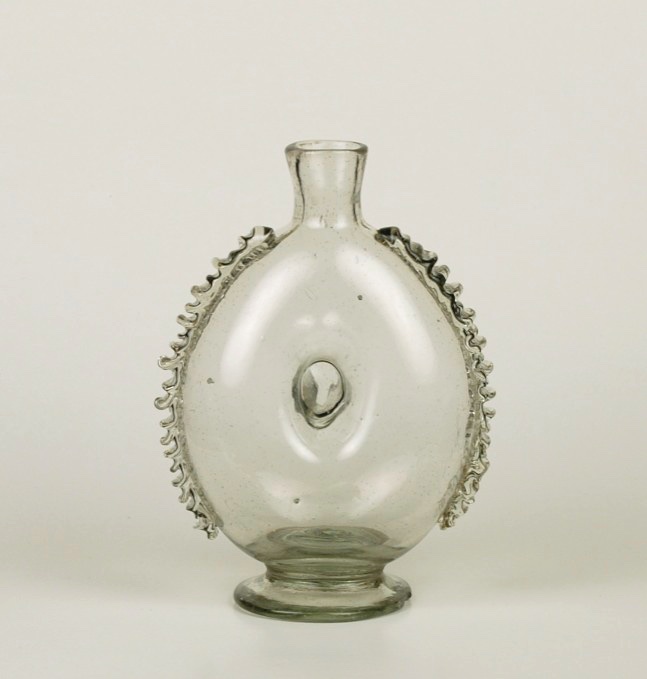










































































































































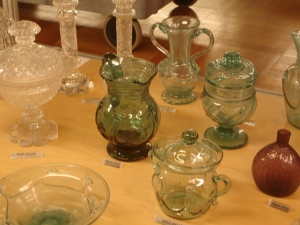























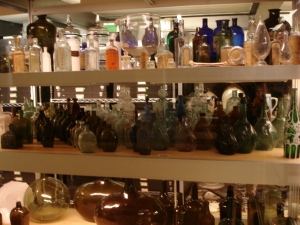

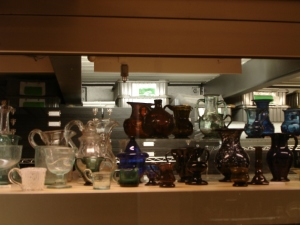











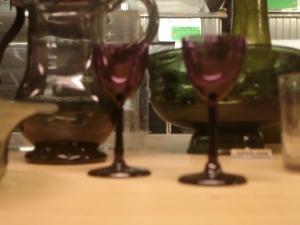
































































































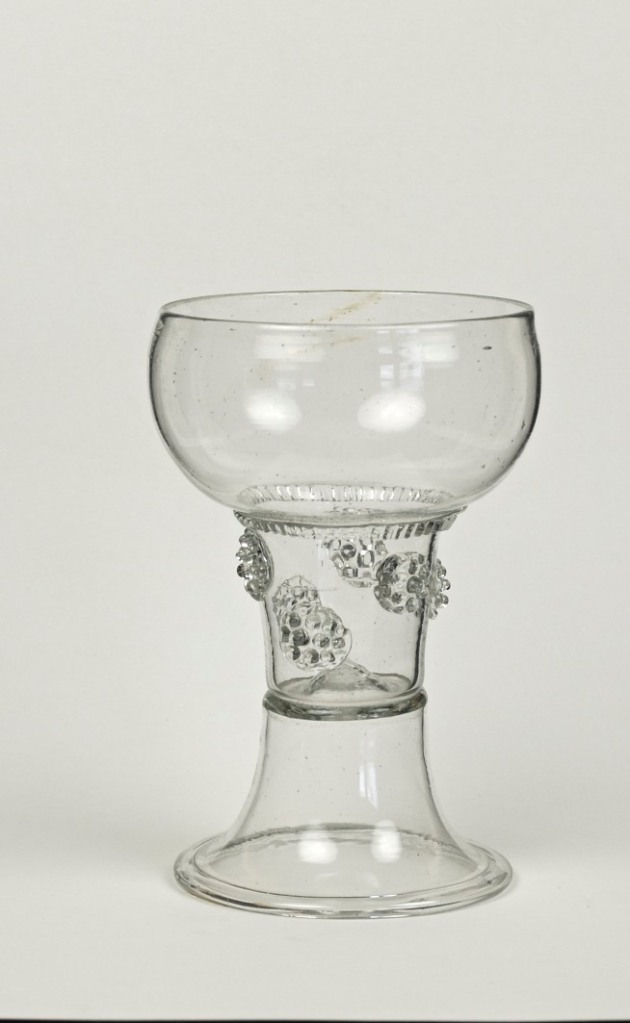
1 comment